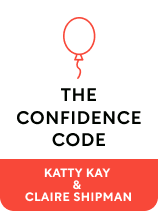

This article is an excerpt from the Shortform book guide to "The Confidence Code" by Katty Kay and Claire Shipman. Shortform has the world's best summaries and analyses of books you should be reading.
Like this article? Sign up for a free trial here .
Is confidence encoded in our biology? Or is it a matter of environment and upbringing? Can self-confidence be built, and if so, to what extent?
Both biological and environmental factors contribute to confidence, but confidence isn’t a fixed trait—you have to build it. Psychologists believe that 50% of developing confidence might come from choice and will.
To this end, Katty Kay and Claire Shipman, the authors of The Confidence Code, devised the following confidence-building techniques.
The Confidence Code
The confidence code—the building blocks of creating confidence—consists of three principles:
- Don’t overthink.
- Act.
- Be authentic.
You can increase your confidence by practicing this code in two ways:
1. Regularly expose yourself to these confidence builders:
- Hard work (pushing yourself, or being pushed by others)
- Persistence (having another go after setbacks)
- Risk (leaving your comfort zone)
- Failure
- Willingness to be different and stand out (working toward what you want, rather than what society tells you to do)
2. Try the following confidence-building techniques:
Technique #1: Fail Fast
The first technique is to fail fast—failing fast is a business strategy that involves trying lots of ideas, expecting that most of them will fail. Then, you abandon the failures early (saving time and money) and only pursue the ideas that have promise.
This is useful as a confidence-building strategy because:
- It combats perfectionism. A high failure proportion is actually the goal, so you won’t be as tempted to do everything perfectly since you know it’s not all supposed to work.
- It saves time. If you’re not trying to do everything perfectly, you have time to master things.
- It’s more manageable. Fast failures are small and non-catastrophic because the failure is so early the stakes aren’t high yet.
- The cycle lends itself to confidence building. Confidence building requires repeated attempts, action, and risk-taking, all of which are an inherent part of failing fast.
- The failure cycles are fast. This makes it hard to find time to ruminate or worry.
- It’s a hip, lucrative business strategy, which gives you confidence that it works—businesses wouldn’t do it if it was ineffective.
- It allows you to build self-compassion. When you fail, you can acknowledge that everyone fails sometimes and that’s normal.
For example, attorney Beth Wilkinson fails fast by regularly making quick decisions. When one of them doesn’t turn out, she learns from it. For instance, she once wrote down her opening argument for a case and read it off a sheet of paper. She overheard a colleague criticize her for reading verbatim, and she realized he had a point—she said everything right, but she didn’t connect with the jury. Reading was a failure, so she stopped doing it.
Technique #2: Act, Even When You’re Uncertain
Taking action is the best way to build confidence, especially when the action is risky, so the second technique is to act. If you stay inactive in your comfort zone, you won’t improve or gain confidence. If you act, the worst thing that will happen is that you fail.
You don’t have to take massive action—it’s fine to start this strategy with baby steps.
- Example #1: If you’re not confident about attending parties solo, first, go to a small event where you know people. (RSVP in advance so you can’t change your mind.)
- Example #2: If you want to ask for a raise or promotion, practice the conversation with a friend first.
Additionally, remember that women have a skewed self-perception of their abilities—you’re probably more capable than you think you are.
Technique #3: Think Differently With Thought Exercises
As discussed in Chapter 3, women’s brains are more active than men’s, and this isn’t an advantage when it comes to confidence because ruminating drains it. Imagining worst-case scenarios isn’t problem-solving; it’s paralyzing, negative feedback.
The third technique is to employ thought exercises to calm your brain:
Exercise #1: Whenever you find yourself ruminating, think of three things you’ve done well that day.
- For example, neuroscientist Laura Ann Petitto used to mentally list all the things she’d done wrong at work on her commute home. Now, whenever she finds herself making negative lists, she pivots and makes lists of achievements and positives.
Exercise #2: Think about something horrible that might happen to you at work—maybe you’re leading a meeting and people start to look bored. Pay attention to how this makes you feel. Then, think about something going well at work—maybe you’ve just been offered a raise. How do these thoughts make you feel? You’ll see that your envisioned scenarios affect your feelings even though they didn’t actually happen. This will prove to you how much your thoughts can affect your emotions and how much you can change.
Sometimes, you can see results from these exercises within weeks.
Reduce Negative Automatic Thoughts (NATs)
There are two strategies for reducing negative automatic thoughts (NATs):
Strategy #1: Recognize and reinterpret. When you have NATs, first, write them down.
- (Shortform example: “My boss has been assigning me a lot more work lately—she must think I’m not working hard enough.”)
Then, look for another (neutral or positive) way to interpret them. This reframing doesn’t have to address the first one, just be different. This will make the first, negative interpretation less powerful.
- (Shortform example: “Maybe my boss likes my work and is asking me to take on more because she knows I’ll do a good job.”)
If you’re having trouble reframing:
- Recall objective facts. (Shortform example: You received a positive performance review, so your boss can’t really hate your work.)
- Imagine what you could tell one of your friends who expressed the same NAT. You’d be compassionate—treat yourself with this same compassion.
Strategy #2: Destroy a symbol of your NATs. Write down your NATs on a piece of paper, and then rip up the paper and throw it out. This symbolic destruction will help you question how accurate the thoughts are.
Technique #4: Change Your Focus
The fourth technique is to change your focus—women tend to be more confident when they focus on others instead of themselves.
- For example, many women are keener to run for office when they think about how being elected would allow them to help and protect people (instead of thinking about how being elected would increase their status).
Therefore, you can spur yourself to act by thinking about how the action will benefit others.
- For example, if you’re nervous about public speaking, boost your confidence by telling yourself you’re speaking on behalf of people or a group you care about.
Another element of focusing on others is remembering that other people are more concerned with themselves than they are with you. If you make a mistake, no one remembers it for long—they’re too busy with their own mistakes and problems.
Technique #5: Take Credit
In the previous technique, you focused on others, but sometimes, you do need to focus on yourself, and the fifth technique is to take credit for your achievements. Many women are self-deprecating, and it probably feels more comfortable than bragging. It’s dangerous, though—you’re spreading the message that you’re undeserving. This is bad for your confidence—you’ll be less likely to try new things. It’s also bad for your workplace success—your boss doesn’t want to hear you’re not good at something; they want to work with people who are skilled and accomplished.
You do deserve your achievements, so take credit for them. If you have trouble taking a compliment, say thank you and tell the person you appreciate them saying it.
Knowing your strengths can make you more confident. (Of course, this doesn’t mean that you should never try to improve.)
Technique #6: Don’t Take Things Personally
The sixth technique to avoid taking things personally—when someone criticizes you at work, remember that this criticism is directed at your work, not you, even in performance fields where you’re constantly scrutinized, such as opera singing.
There are two strategies to taking things less personally:
1. Say or think “thank you” whenever someone criticizes you.
- For example, opera singer and voice teacher Chrissellene Petropoulos was criticized for everything from her singing to her appearance. At first, she took it personally—which was dangerous, because stress does damage to the vocal cords—but then she started attributing the criticism to her skills. She also thanks people for criticism—this helps her from taking it personally.
2. Recognize that women face some obstacles men don’t and this makes things harder for them. Women aren’t incompetent or less capable; their lives are harder and they don’t have access to the same resources as men. (Don’t let this make you give up or complain though.)
- For example, if you go to a meeting and only 1% of the participants are women, it’s natural to feel nervous—you don’t have to criticize yourself for feeling apprehensive.
Technique #7: Become More Comfortable Speaking Up
The seventh technique is to find strategies to help you become more comfortable speaking up. Many people aren’t confident about public speaking, and fear of it is the top reason women don’t pursue electoral politics.
Improve your confidence and speaking abilities by:
- Using whatever style is most comfortable. There’s no need to copy other successful speakers’ styles. You’ll appear more authoritative if you’re authentic.
- Focusing on others. If you talk about collective goals and accomplishments, you’ll naturally speak with more purpose and mission.
- Avoiding upspeak (when the pitch of your voice rises at the end of a sentence, making it sound like you’re asking a question). You might be tempted to do it because it’s a safety net—if you’re asking rather than stating, it’s harder to criticize or challenge you—but it’s distracting and makes you sound underconfident. (Men rarely upspeak.)
(Shortform note: For more ideas on improving your public speaking, read our guide to Talk Like TED.)
Technique #8: Remember Your External Achievements
Interestingly, though a lot of advice about confidence is along the lines of changing your attitude, to access confidence, you actually need to distance yourself from your thoughts. The eighth technique is to remember your external achievements—you become confident when you remember there’s proof you’ve been successful in the past, and this realization is more powerful than any self-perception.
- For example, when Katty was reporting at the White House, she was afraid to ask a question during the question period because she worried she’d sound stupid. Most of the other journalists were men, and all seemed confident. However, Katty forced herself to ask a question, and she didn’t sound stupid. Now, anytime she finds herself in a similar position, she can remember that she’s asked questions before, so she can do it again.
Technique #9: Do Things Differently If Necessary
The ninth technique is to be authentic—few women hold high positions, so once you reach this stage, you’re going to be different and unique, and you’re going to stand out. It can be lonely and you can choose how to feel about it: Resent it or embrace it.
You don’t need to evaluate yourself against the same criteria the men use—that wouldn’t be authentic. You’ll be challenged if you do things differently, but if you believe your way is the best option, do it anyway.
- For example, in one country, it’s accepted practice for the president to be accompanied by a 25-car entourage when leaving the palace. A newly elected woman president decided to take only five cars because the government was broke, and a smaller entourage would save money. Everyone criticized her, especially women, because the decision implied she felt less important than male presidents. But she stuck to her five cars because she thought the savings were important.
Additionally, you get confidence from doing things in whatever way is most authentic for you, even if that’s different from how other people do things.
- For example, Major General Jessica Wright is confident because she’s bold and stands up for herself. For instance, when a superior told her he didn’t like having women in the military, she told him she was an opportunity for him to get over that. She’s also confident because she does what she wants, regardless of what men think of it. For instance, she regularly gets her hair and nails done.
Technique #10: Don’t Rely on External Sources of Confidence
The last technique is to avoid a dangerous pitfall. Some people (some studies suggest women more than men) get confidence from external sources (like compliments from other people) rather than self-belief. There’s nothing wrong with comparing yourself to others and enjoying external validation, but it’s dangerous to rely on it as a source of confidence because:
- You’re less likely to act because if you fear the action might make people stop praising you.
- Anytime the compliments flag (which they inevitably will, because even the most praisable people can’t be constantly complimented), you’re vulnerable.
For example, one study found that college students who relied on others for validation were more stressed and had a higher incidence of eating disorders and drug use.
Extra Tips
In addition to the techniques in this chapter, here are some smaller things you can do to improve your confidence:
- Meditate. As noted in Chapter 3, during meditation, your amygdala shrinks, and you have more control of your emotions. Being calm will make you feel more confident.
- Be thankful. Say the words “thank you” whenever you get the opportunity and be grateful for small things, such as someone letting you merge in traffic. This will help you be happy and optimistic.
- Break problems into smaller parts. As you achieve each part, your confidence will grow, helping you tackle the next parts.
- Exercise and sleep. If you don’t get enough of either of these, your brain becomes anxious.
- Socialize with friends. This will increase your oxytocin.
- Use power postures. Sit up straight and lift your chin. Nod as you talk—this will encourage others to agree with you and make you feel more confident.
One thing you shouldn’t try is faking confidence. Faking doesn’t build confidence because:
- Confidence comes from hard work and accomplishment, and faking it isn’t based in either of these things.
- Faking makes you anxious.
- Other people can usually tell when you’re faking because you send unintentional signals that reveal you’re acting.
If you’re tempted to fake confidence, instead, take action.

———End of Preview———
Like what you just read? Read the rest of the world's best book summary and analysis of Katty Kay and Claire Shipman's "The Confidence Code" at Shortform .
Here's what you'll find in our full The Confidence Code summary :
- An examination of the art and science of confidence
- Why women have more trouble accessing confidence than men
- How to build confidence in yourself and others






